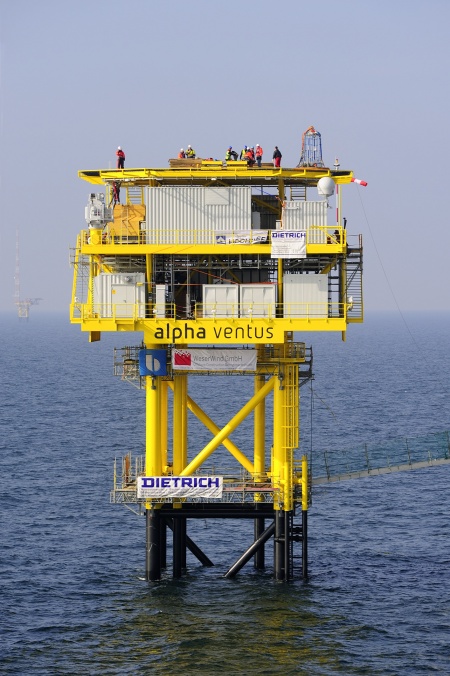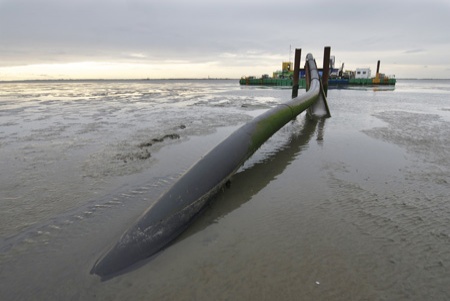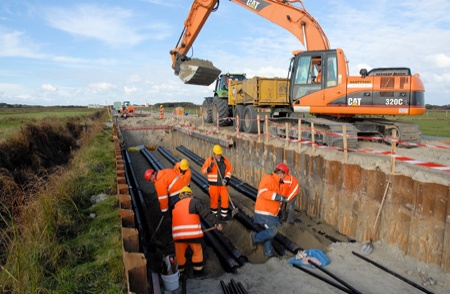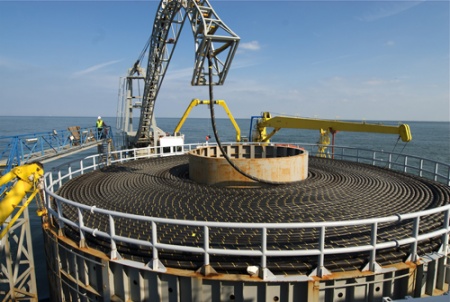Grid Connection

Without cables and a substation, the energy from offshore wind farms cannot be transported from the sea to the shore. The 1,300-ton substation is, so to speak, the heart of alpha ventus. Its main deck is 25 metres above sea level. The platform has a workshop, emergency accommodation, a helicopter deck and a docking facility for ships. Here, the energy from all of the wind farm's turbines is collected and is converted to 110 kilovolts.
From the substation, the energy is then transported through a 60-kilometre cable crossing the island of Norderney, to the substation in Diele. For the grid connection, some of the cables were laid through the sensitive Wadden Sea, which is a natural UNESCO World Heritage Site. Therefore, strict environmental requirements had to be met for the work and special machines were used, which reduced the environmental impact to a minimum. To be able to connect additional wind farms, transpower (known as E.On Netz until 2009), in its capacity as the network operator for the project, has installed a 1.5-kilometre empty pipe construction under the island of Norderney, where additional cables can be installed without complex construction.
Foto: German Offshore Wind Energy Foundation, DOTI, Matthias Ibeler, 2008
Cable construction for alpha ventus

The geographic conditions present particular challenges for cable laying at the German North Sea coast because of the Wadden Sea National Park, a conservation area. The cable track to connect alpha ventus and other offshore wind farm crosses the national park across the island of Norderney and through the Wadden Sea to the mainland. Minimally invasive construction is of paramount importance and is continuously monitored by nature conservationists.
Foto: German Offshore Wind Energy Foundation, E.ON-Netz, Detlef Gehring, 2008
Crossing the island of Norderney

The cable track was placed under existing roads and paths on the island of Norderney. During the winter of 2007-08, outside of the main tourist season, cable pipes were installed for a total of 9 three-phase and 4 direct-current connections from offshore wind farms into a filling bed made of a sand-cement mixture. This mixture is water-permeable and thus allows a natural cooling of the track through ground water.
Foto: German Offshore Wind Energy Foundation, E.ON-Netz, Detlef Gehring, 2007
Offshore grid connection
 From the island seawards, the installation procedure essentially corresponded to the usual procedure when no protection zones require special precautions. Approximately four kilometres off the island of Norderney, at a depth of 10 metres, a few kilometres of the 60 km of cable stored on the cable vessel were rewound onto a barge. The cable vessel from there made its way to the offshore wind farm and installed the cable into the seabed with the help of a jet plough. The barge moved along anchors towards the shore where it could fall dry. It did not have its own engine and therefore had to be manoeuvred along previously installed anchors and cable pulls. The vertical injector, which is connected to the barge, flushes the cable into the seabed with water pressure. On land, the remaining length of the cable was unwound, laid out and pulled through an empty pipe which had been previously installed under the dunes.
From the island seawards, the installation procedure essentially corresponded to the usual procedure when no protection zones require special precautions. Approximately four kilometres off the island of Norderney, at a depth of 10 metres, a few kilometres of the 60 km of cable stored on the cable vessel were rewound onto a barge. The cable vessel from there made its way to the offshore wind farm and installed the cable into the seabed with the help of a jet plough. The barge moved along anchors towards the shore where it could fall dry. It did not have its own engine and therefore had to be manoeuvred along previously installed anchors and cable pulls. The vertical injector, which is connected to the barge, flushes the cable into the seabed with water pressure. On land, the remaining length of the cable was unwound, laid out and pulled through an empty pipe which had been previously installed under the dunes.
Foto: German Offshore Wind Energy Foundation, E.ON-Netz, Detlef Gehring, 2008